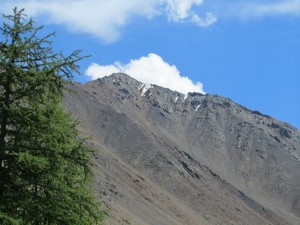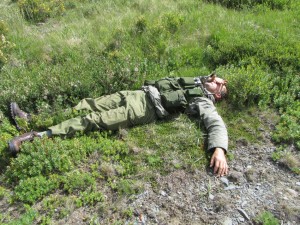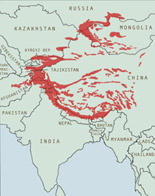
High ridges and stunning scenery in our search for the Russian snow leopard. Photo by Sibylle Noras.
What would it be like to drive and trek the remote Altai Mountains in southern Siberia to search for Russia’s last snow leopards? In July 2010 I found out. This is my diary of an amazing trip to survey these beautiful mountains for the rare and elusive cat.
Vladimir (Volodya) Tytar, a jolly, 58 year old biologist from Kiev Academy of Sciences, has been researching snow leopards for the last five years with Biosphere Expeditions. He believes “there are maybe only 40 snow leopards left in Russia and the Altai is the extreme north of their range. They can’t go much further north because then there is too much snow and they can’t hunt prey as well. Perhaps this cat should be called a rock leopard, because it spends so much of its time on rocky mountains.”
But snow leopard habitat is so large, hundreds of square kilometers in fact, that Volodya needs help to survey the region so I joined the team to do this with him this year.

Vladimir Tytar, snow leopard researcher in remote Altai Mountains in Russia. Photo by Sibylle Noras.
Days 1-2
Our meeting place was Novosibirsk, capital of Siberia in southern Russia. We were a multinational group – Joanne from Canada, Nancy and Paul from USA, Madeleine from Switzerland, Sharareh from Germany, Viv and Peter from UK, Birgit and Eva from Austria and me from Australia. We also had two lovely young Russian biology students with us, Sasha and Julia. All hands and eyes would be needed to survey animal sign in the rugged mountains.
Our hard working team leader was Andy Stronach, a wiry and fit Scottish guy, ex-air force, full of jokes, passionate about his work and photography.

A typical wooden house on the Russian steppe near Altai mountains. Photo by Sibylle Noras.
For 2 days we drove almost 1000km south from Novosibirsk to the Altai Republic. The road was treacherous in parts, narrow and tight with blind corners and often the drivers ignored double lines and common sense. We saw flowers and crosses commemorating road deaths every 10 or so kms. In fact some of these memorials were so big I asked Volodya, who said often poor people buried their family members right by the side of the road where the car accident had occurred.
The Altai is a land of beautiful green mountains, not as stark and high as Himalayas, more soft and rounded like the mountains of Austria and Switzerland. We drove through lush thick forests of birch, larch and pines. We passed tiny villages of wooden huts, some new and ornate, others old and simple with bright blue window frames winking at us Everybody has a small plot of vegetables growing in the rich black soil.
We followed the course of some mighty rivers and late afternoon on the second day we got to the steppe and the small town of Kosh Agach (meaning ‘last tree’). Kosh Agach is an amazingly bleak and windswept place, brown steppe dust covered roads and meagre houses. Picture all those wild towns you’ve seen in old American westerns. But the women still proudly walk around on colored spiky high heels, their feet encased in bright low lace socks, obviously the latest fashion.

Everywhere we surveyed for snow leopard we found beautiful wildflowers. Photo by Sibylle Noras.
The steppe is a huge area of broad flat grasslands, which we discovered over the next 2 weeks to be covered in a sea of rainbow colored wildflowers. Summer temperatures are around 30 degrees but night times often freezing. There’s a layer of permafrost, meaning the soil under ground never gets warm enough, even in high summer, to melt.
From Kosh Agach we took the land rovers to our Base camp at 2300m near the beautiful Tapduair Mountain and Bugason river. For the next 2 weeks home was a narrow valley on a clear stream, with flat land for our dozen tents and the large dining tent.
Our Russian support team consisted of Nina the cook, (who could conjure magic from tinned supplies without a fridge, kept cold only in pots firmly wedged in the rocks of our icy stream). There was smiling Oleg, the guide who supported many of us on perilous paths; Sasha our driver, who managed to coax life out of an amazing red devil of a Russian 4 wheel drive vehicle that had seen better days. Emil, our youngest at 15, was the all round camp helper who boiled huge tin buckets of water on open fires each day to give us a 30 second shower at the end of our weary survey treks. Thanks Emil, those little showers kept me going 

My home for two weeks in Altai mountains. Photo Sibylle Noras.
Day 3
We woke to below freezing temperatures; the night had frozen the tent fly to a solid board. Today was training day, learning to handle GPS (to record the location of animal sign) and compass reading. A few of us with international driving licences learnt to drive the Land Rovers, up hills, down hills, across rivers, along rivers. I had no idea these cars could roll and pitch and shudder us across boulders, scree, grassland, and hills. Not to mention drive slowly! down a steep mountain without using the brakes. I still dream about the Land Rover instructions – low gear, second gear, differential off, thumbs back, both feet on the floor.
Volodya gave us serious animal survey training and tried to fashion a bunch of city slickers into effective field biologists in a matter of hours. But we were fast learners – photograph anything that moves and pick up the remains of anything that once moved but doesn’t any more.

Landrovers helped us cover the huge area of snow leopard territory on our survey.We’d drive across the steppe to valleys and then walk the hills to scan for animal sign.
Volodya has done five years of surveying this snow leopard ecosystem, each year in summer. He is amazingly dedicated and I’m sure the snow leopards must thank him, even though he hasn’t ever seen a wild one. He’s seen pugmarks (prints) and scat and scrapes so he knows at least a few of the cats are there. “The main thing is we find prey species, because then in theory the snow leopard could take up habitat here and sustain itself,” he says. The possibility of the cat being here is why he comes back with volunteer researchers every year.

Writing up the survey data in the dining tent. Photo by Sibylle Noras.
Days 4 to 14
We had a challenging routine for these days – get up about 7 or 7.30 am, struggle to get dressed in a small tent (I’m really getting too old for this!) go to loo (holes in the ground with orange tent covering 100m from camp), then 8 am breakfast with Nina trying to get everyone to eat the thick porridge she makes, then pack day pack with lots of emergency stuff, lunch and binoculars.
Snow leopards move across vast territory and we needed to cover as much of this area as we could. We’d usually split into groups and either trek out from base camp or drive with the Land Rovers across the steppe to another valley and trek from there, searching for any animal, bird and human signs. The mountains had a very severe winter so there is still lots of snow and ice on the peaks. This means a lot of water and unfortunately for us, millions of mosquitoes and march flies. We were covered in bites from head to foot and spent many hours comparing efficacy of insect repellent. Our finding – Altai insects are immune to everything!
On survey days we’d have a lunch stop somewhere with our packed lunches about mid afternoon with a short rest for tired muscles. During the day we’d take a note of everything we saw as well as take photographs. Each night in camp, after a delicious Nina dinner, we’d fill in the data sheets, recording all animals and birds, human habitation, with GPS location and any comments. This data forms the basis of Volodya’s annual scientific reports. Then there was time for stories, learning about animal behaviour and ecology. After this most of us would fall exhausted into our tents while a few others, (you know who you are!) continued with Russian cultural activities ie/ sampling the local vodka.

One of the many ground squirrels we saw. Snow leopards will eat these little animals but can’t survive on them. Photo by Sibylle Noras.
During our surveys we were delighted to find sign of argali, the rare and endangered wild sheep of the area. We found scat and a hoof print in a muddy stream. Argali are one of the main animals hunted by snow leopards; they are huge but a snow leopard can kill an animal three times its own weight. Sadly argali are also hunted by humans and we saw at least one hunter’s camp. The high altitude trekkers in our team saw a herd of ibex one day, coming across them over a hidden ridge. We were thrilled that ibex still inhabit this area as these wild goats are also snow leopard prey, sadly getting less common as years go by.
We saw and photographed hundreds of birds, and for a non birdo I actually learnt to tell the difference between some of them! Demosielle cranes dancing in the evening, kites, lammergeier vulture, dotterel wading birds in the lake, and the ever present little wheat ears, which I thought of as the sparrows of the steppe.
We saw thousands of tiny ground squirrels (oh, not another ground squirrel!), pika and marmot (two small ground mammals that can provide a snow leopard with snacks), scat of a roe deer, sign of weasel and a couple of foxes frolicking in the morning dew. One day while resting in the sun next to my tent, I saw a funny animal dating session. The little gray vole that lived under my tent (a small mouse like creature) ran out and approached a marmot that sat about 3 m away from me, twitching its nose in the air. The marmot, which had been standing on hind legs, crouched down and the two rubbed lips! The vole musn’t have been impressed, it raced off back under my tent while the marmot stood transfixed. Ah, love the world over.
I was also lucky to see a small lizard scuttling amongst the wildflowers. It’s a viviparous lizard, meaning it gives birth to live young because it’s far too cold for eggs. Looked like Australian lizards to me.

Local herder family in their yurt. We interviewed herders about snow leopard sightings. Photo by Sibylle Noras.
The trip wasn’t all wildlife though. We had some time to explore the local culture as well. One morning we visited the tiny village of Kokoria and researched all the sweets and alcohol in the one and only village shop. We spent time in the brand new museum with its artifacts and photos of all the village dignitaries. The school next door was having a music festival and we watched as the kids laughed their way through a witch pantomime.
In the afternoon we hiked up a rocky hill to see the age old carved stones of the region, called petroglyphs. They showed hunting scenes with ibex and fishing scenes. It was wondrous to be able to stand in the cold icy wind and look down upon these works of art just as the makers had done over 2000 years ago.

Andy, team leader, hard at work. Photo by Sibylle Noras.
One lazy day Andy and a few of us drove (!) up hills to 2900m and sat for hours scanning the ridges for argali and ibex. The beautiful Chichova ranges in Mongolia shimmered so close by I felt I could leap over them.
We met local herders in their portable yurts and interviewed them about their attitude towards snow leopards and find out if they have seen any. None of our herders had seen them and were quite friendly towards the cats, which is probably due to the fact that none of them are killing their domestic livestock.
One of the highlights for me was to be invited inside the yurts to see all the furniture and cooking implements. As an interior design freak the wall hangings, the rugs, and the beautiful wooden carved stools and chests fascinated me.

A petroglyph, this one a large wild sheep with huge horns carved 2000 years ago on rock. Photo by Sibylle Noras.
All the families were friendly and house-proud. We met a herder who had rolled his truck and badly crunched it on the river rocks. In return for his hospitality a few of the tough guys in our group drove back in one of our land rovers and towed it back to his camp for him. It looked badly damaged, crumpled, without brakes or clutch, or indeed any working part to the whole engine. Not too sure what he’ll do with it, next time he moves his sheep and goats and yurt and family, he’ll have to get someone else to tow the truck again.
Final Day

The herders were all welcoming. This is one of the many yurts we visited to interview owners about snow leopard sightings. Photo by Sibylle Noras.
It had been a wonderful experience, fun and challenging. Many tired muscles later we drove back to Novosibirsk (lots of souvenir and kebab stops on the way) and had a farewell dinner. We toasted Volodya’s work and our success. We had not expected to see snow leopards. It was summer and they were at much higher altitudes but it would have been great. Still, we had a wonderful time, challenged ourselves in many ways, learned a lot about this beautiful environment and the local people living there, and had contributed to snow leopard conservation in this remote part of Russia. Read more about Russia’s fight to save its snow leopards.



